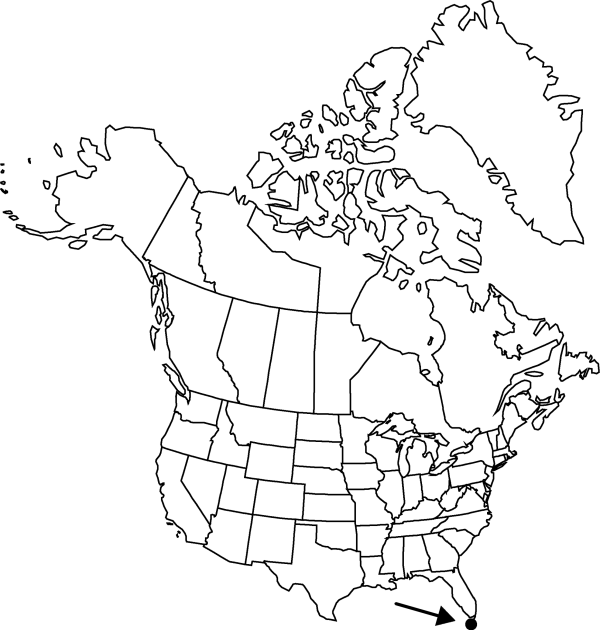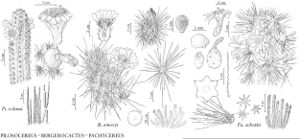Difference between revisions of "Pilosocereus robinii"
Cact. Succ. J. Gr. Brit. 19: 67. 1957.
FNA>Volume Importer |
imported>Volume Importer |
||
| (6 intermediate revisions by 2 users not shown) | |||
| Line 8: | Line 8: | ||
}} | }} | ||
|common_names=Key tree cactus | |common_names=Key tree cactus | ||
| − | |basionyms={{Treatment/ID/ | + | |special_status={{Treatment/ID/Special_status |
| + | |code=F | ||
| + | |label=Illustrated | ||
| + | }}{{Treatment/ID/Special_status | ||
| + | |code=C | ||
| + | |label=Conservation concern | ||
| + | }} | ||
| + | |basionyms={{Treatment/ID/Basionym | ||
|name=Pilocereus robinii | |name=Pilocereus robinii | ||
|authority=Lemaire | |authority=Lemaire | ||
| + | |rank=species | ||
| + | |publication_title=Ill. Hort. | ||
| + | |publication_place=9: 74. 1864 (as robini) | ||
}} | }} | ||
|synonyms={{Treatment/ID/Synonym | |synonyms={{Treatment/ID/Synonym | ||
|name=Cephalocereus deeringii | |name=Cephalocereus deeringii | ||
|authority=Small | |authority=Small | ||
| − | }}{{Treatment/ID/Synonym | + | |rank=species |
| + | }} {{Treatment/ID/Synonym | ||
|name=Cephalocereus keyensis | |name=Cephalocereus keyensis | ||
|authority=Britton & Rose | |authority=Britton & Rose | ||
| − | }}{{Treatment/ID/Synonym | + | |rank=species |
| + | }} {{Treatment/ID/Synonym | ||
|name=Cereus robinii | |name=Cereus robinii | ||
|authority=(Lemaire) L. D. Benson | |authority=(Lemaire) L. D. Benson | ||
| − | }}{{Treatment/ID/Synonym | + | |rank=species |
| + | }} {{Treatment/ID/Synonym | ||
|name=Cereus robinii var. deeringii | |name=Cereus robinii var. deeringii | ||
|authority=(Small) L. D. Benson | |authority=(Small) L. D. Benson | ||
| − | }}{{Treatment/ID/Synonym | + | |rank=variety |
| + | }} {{Treatment/ID/Synonym | ||
|name=Cereus robinii var. keyensis | |name=Cereus robinii var. keyensis | ||
|authority=(Britton & Rose) L. D. Bens on ex R. W. Long & Lakela | |authority=(Britton & Rose) L. D. Bens on ex R. W. Long & Lakela | ||
| − | }}{{Treatment/ID/Synonym | + | |rank=variety |
| + | }} {{Treatment/ID/Synonym | ||
|name=Pilosocereus deeringii | |name=Pilosocereus deeringii | ||
| − | |authority= | + | |authority= |
| − | }}{{Treatment/ID/Synonym | + | |rank=species |
| + | }} {{Treatment/ID/Synonym | ||
|name=Pilosocereus keyensis | |name=Pilosocereus keyensis | ||
| − | |authority= | + | |authority= |
| − | }}{{Treatment/ID/Synonym | + | |rank=species |
| + | }} {{Treatment/ID/Synonym | ||
|name=Pilosocereus robinii var. deeringii | |name=Pilosocereus robinii var. deeringii | ||
|authority=(Small) Kartesz & Gandhi | |authority=(Small) Kartesz & Gandhi | ||
| + | |rank=variety | ||
}} | }} | ||
|hierarchy=Cactaceae;Cactaceae subfam. Cactoideae;Pilosocereus;Pilosocereus robinii | |hierarchy=Cactaceae;Cactaceae subfam. Cactoideae;Pilosocereus;Pilosocereus robinii | ||
| Line 52: | Line 70: | ||
|distribution=Fla.;Mexico;West Indies. | |distribution=Fla.;Mexico;West Indies. | ||
|discussion=<p>Of conservation concern.</p><!-- | |discussion=<p>Of conservation concern.</p><!-- | ||
| − | --><p>In the flora, Pilosocereus robinii has been known historically from Key West to Key Largo, Florida, but is now restricted to Upper and Lower Matecumbe Keys, Long Key, and Big Pine Key. Pilosocereus keyensis and P. deeringii were originally described (as Cephalocereus species) from Key West and Lower Matecumbe Key, respectively, where they supposedly were endemic. Recent authors (D. F. Austin 1984; A. N. Lima and R. N. Adams 1996; R. P. Wunderlin and B. F. Hansen, www.plantatlas.usf.edu) have considered them to be within the range of variation of P. robinii. Although E. F. Anderson (2001) treated all of those named variants and others as merely insular forms of P. polygonus (Lamarck) Byles & G. D. Rowley, such treatment remains to be supported by a populational study throughout the West Indian range of the taxa.</p><!-- | + | --><p>In the flora, <i>Pilosocereus robinii</i> has been known historically from Key West to Key Largo, Florida, but is now restricted to Upper and Lower Matecumbe Keys, Long Key, and Big Pine Key. <i>Pilosocereus</i> keyensis and P. deeringii were originally described (as Cephalocereus species) from Key West and Lower Matecumbe Key, respectively, where they supposedly were endemic. Recent authors (D. F. Austin 1984; A. N. Lima and R. N. Adams 1996; R. P. Wunderlin and B. F. Hansen, www.plantatlas.usf.edu) have considered them to be within the range of variation of <i>P. robinii</i>. Although E. F. Anderson (2001) treated all of those named variants and others as merely insular forms of P. polygonus (Lamarck) Byles & G. D. Rowley, such treatment remains to be supported by a populational study throughout the West Indian range of the taxa.</p><!-- |
| − | --><p>In 1992, a clone identified as Pilosocereus bahamensis (Britton & Rose) Byles & G. D. Rowley was discovered in a rock hammock surrounded by mangrove swamp on Key Largo, Florida. E. F. Anderson (2001) also included that species as a synonym of P. polygonus.</p><!-- | + | --><p>In 1992, a clone identified as <i>Pilosocereus</i> bahamensis (Britton & Rose) Byles & G. D. Rowley was discovered in a rock hammock surrounded by mangrove swamp on Key Largo, Florida. E. F. Anderson (2001) also included that species as a synonym of P. polygonus.</p><!-- |
--><p>When main stems fall to the ground, for whatever reason, the lateral branches develop into plants with the ‘unbranched’ pattern that was the basis for Small’s concept of Cephalocereus deeringii (D. F. Austin 1984).</p><!-- | --><p>When main stems fall to the ground, for whatever reason, the lateral branches develop into plants with the ‘unbranched’ pattern that was the basis for Small’s concept of Cephalocereus deeringii (D. F. Austin 1984).</p><!-- | ||
--><p>According to L. D. Benson (1982), when the flowers initially open in the afternoon they may have an odor of onion or garlic.</p><!-- | --><p>According to L. D. Benson (1982), when the flowers initially open in the afternoon they may have an odor of onion or garlic.</p><!-- | ||
| − | --><p>Pilosocereus robinii is in the Center for Plant Conservation’s National Collection of Endangered Plants.</p> | + | --><p><i>Pilosocereus robinii</i> is in the Center for Plant Conservation’s National Collection of Endangered Plants.</p> |
|tables= | |tables= | ||
|references= | |references= | ||
| Line 65: | Line 83: | ||
-->{{#Taxon: | -->{{#Taxon: | ||
name=Pilosocereus robinii | name=Pilosocereus robinii | ||
| − | |||
|authority=(Lemaire) Byles & G. D. Rowley | |authority=(Lemaire) Byles & G. D. Rowley | ||
|rank=species | |rank=species | ||
| Line 79: | Line 96: | ||
|publication title=Cact. Succ. J. Gr. Brit. | |publication title=Cact. Succ. J. Gr. Brit. | ||
|publication year=1957 | |publication year=1957 | ||
| − | |special status= | + | |special status=Illustrated;Conservation concern |
| − | |source xml=https:// | + | |source xml=https://bitbucket.org/aafc-mbb/fna-data-curation/src/2e0870ddd59836b60bcf96646a41e87ea5a5943a/coarse_grained_fna_xml/V4/V4_344.xml |
|subfamily=Cactaceae subfam. Cactoideae | |subfamily=Cactaceae subfam. Cactoideae | ||
|genus=Pilosocereus | |genus=Pilosocereus | ||
Latest revision as of 21:58, 5 November 2020
Plants erect, normally with few–many, closely parallel branches forming a narrow crown. Stems light to deep green, or blue-green especially when young; ribs 9–13; areoles copiously hairy; hairs deciduous to persistent, long or short. Spines 9–31 per areole; longest spines 10 mm. Flowers campanulate, 5–6 cm; outer tepals light green with brownish midstripes, ovate to obovate, apex acute to obtuse; inner tepals white; outermost ovate to elliptic, innermost oblanceolate to broadly linear. Fruits sometimes with 1–2 scales. Seeds 2 mm.
Phenology: Flowering (Mar-)Aug–Sep; fruiting year-round.
Habitat: Upland tropical hardwood hammocks, "cactus hammocks" (low elevation thorn scrub), sandy soils, nearly bare coral rock
Elevation: 0-10 m
Distribution

Fla., Mexico, West Indies.
Discussion
Of conservation concern.
In the flora, Pilosocereus robinii has been known historically from Key West to Key Largo, Florida, but is now restricted to Upper and Lower Matecumbe Keys, Long Key, and Big Pine Key. Pilosocereus keyensis and P. deeringii were originally described (as Cephalocereus species) from Key West and Lower Matecumbe Key, respectively, where they supposedly were endemic. Recent authors (D. F. Austin 1984; A. N. Lima and R. N. Adams 1996; R. P. Wunderlin and B. F. Hansen, www.plantatlas.usf.edu) have considered them to be within the range of variation of P. robinii. Although E. F. Anderson (2001) treated all of those named variants and others as merely insular forms of P. polygonus (Lamarck) Byles & G. D. Rowley, such treatment remains to be supported by a populational study throughout the West Indian range of the taxa.
In 1992, a clone identified as Pilosocereus bahamensis (Britton & Rose) Byles & G. D. Rowley was discovered in a rock hammock surrounded by mangrove swamp on Key Largo, Florida. E. F. Anderson (2001) also included that species as a synonym of P. polygonus.
When main stems fall to the ground, for whatever reason, the lateral branches develop into plants with the ‘unbranched’ pattern that was the basis for Small’s concept of Cephalocereus deeringii (D. F. Austin 1984).
According to L. D. Benson (1982), when the flowers initially open in the afternoon they may have an odor of onion or garlic.
Pilosocereus robinii is in the Center for Plant Conservation’s National Collection of Endangered Plants.
Selected References
None.
